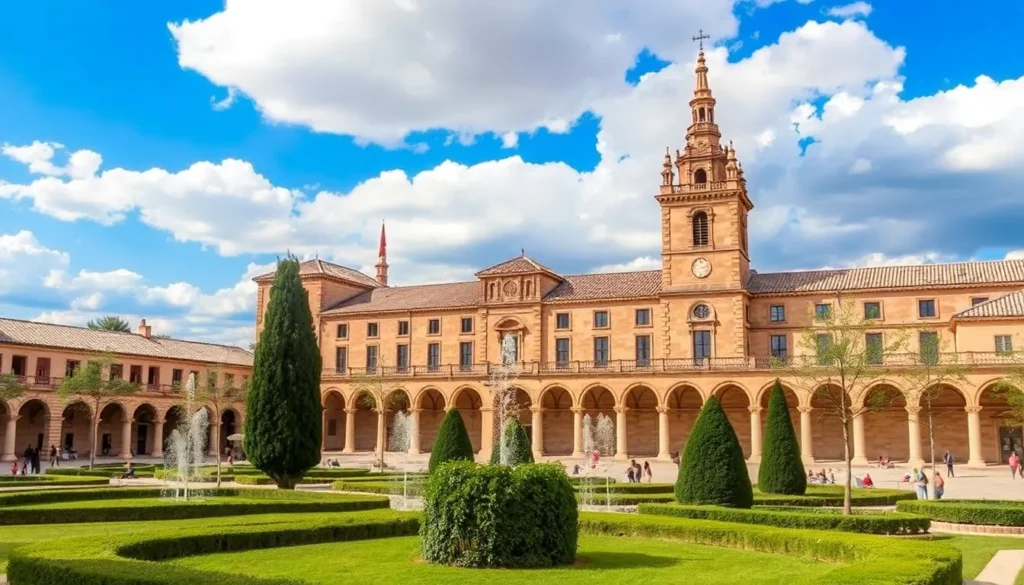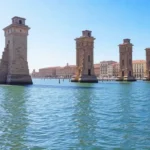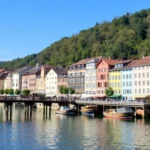15 things to do and see in Alcalá de Henares

Alcalá de Henares, a city steeped in history and culture, invites you to explore its many treasures. Recognized as a UNESCO World Heritage Site since 1998, this vibrant destination is not only the birthplace of the illustrious Miguel de Cervantes but also a hub of educational and architectural significance. Whether you are a history buff, a literary enthusiast, or simply looking for a charming getaway, Alcalá has something for everyone. Let’s dive into the 15 must-see attractions and activities that will make your visit unforgettable.
* At the end of this article, you will find a wealth of useful information to help plan your visit to Alcalá de Henares effectively.
Although often overshadowed by the bustling capital of Madrid, Alcalá de Henares is far from being just another suburban city. It boasts a lively atmosphere, rich history, and a plethora of sights and activities that will captivate any traveler. From its historic university to the birthplace of Cervantes and a culinary scene worthy of exploration, Alcalá de Henares is a treasure trove waiting to be discovered. Grab your walking shoes, and let’s embark on a journey through its enchanting streets!
Exploring the rich history of Alcalá de Henares
The journey begins at one of the most significant educational institutions in Europe:
1. Universidad de Alcalá
Founded in 1499, the Universidad de Alcalá is recognized as the first planned university city in the world. It was established by Cardenal Cisneros, a pivotal figure in Spanish history, who envisioned a space dedicated to knowledge and culture.
Many of Spain's literary giants, including Lope de Vega and Calderón de la Barca, walked these hallowed halls. Exploring the university, particularly the Colegio Mayor de San Ildefonso, allows visitors to appreciate its stunning plateresque façade and beautiful courtyards. Don’t miss the Paraninfo, where the Cervantes Prize is awarded, and the Capilla de San Ildefonso, housing a magnificent cenotaph dedicated to Cardenal Cisneros.
Tip: The Colegio is primarily used for administrative purposes but is open to the public from Monday to Friday. For a deeper experience, join a guided tour to access the most interesting areas, which you can book through the University's website.
2. Calle Colegios
Strolling down Calle Colegios, visitors can glimpse the rich educational legacy of Alcalá. This street was home to 40 lesser colleges, which provided education to less affluent students. Some of these historic institutions still serve as faculties of the university today.
Take the opportunity to visit the Colegio de Málaga, now the Faculty of Philosophy and Letters, or the former Colegio de Santo Tomás, which has been transformed into one of Alcalá's two Paradores.
3. Casa Natal de Cervantes
No visit to Alcalá would be complete without a trip to the Casa Natal de Cervantes, the birthplace of the legendary author of Don Quijote. Today, this house serves as a museum that recreates a typical Spanish home from the 16th and 17th centuries.
Inside, you can find period furniture and a remarkable collection of different editions of Cervantes' works. Admission is free, but the museum is closed on Mondays. Nearby, don’t forget to snap a selfie with the iconic statue of Don Quijote and Sancho Panza.
Fun Fact: Although Cervantes is often referred to as “the one-handed man of Lepanto,” he actually retained both hands after his injuries in the battle.
4. Hospital de Antezana
Established in 1483, the Hospital de Antezana is one of the oldest continuously operating hospitals in the world. This medieval palace showcases stunning architecture with multiple rooms surrounding a central courtyard.
Guided tours (for a fee of 3€) provide insight into the hospital’s history and allow you to view valuable artifacts and documents from its extensive archives. More Info.
5. Calle Mayor
The vibrant Calle Mayor is Alcalá's main thoroughfare, lined with charming shops, bars, and restaurants. Steeped in history, this pedestrian-friendly street retains remnants of its Roman past, including columns that serve as reminders of its ancient origins.
As you explore, take a moment to enjoy the lively atmosphere and perhaps indulge in some local sweets, as the people of Alcalá have a well-known passion for desserts!
Architectural Wonders and Cultural Significance
Continuing your exploration, you’ll discover a wealth of architectural gems:
6. Placas de las 3 culturas
Alcalá is a testament to Spain's rich cultural tapestry, where three cultures—Muslim, Jewish, and Christian—coexisted for centuries. Although much has been lost since the expulsion in 1492, the city honors its diverse heritage with plaques identifying the distinct neighborhoods: the Jewish quarter, the Muslim area, and the Christian district.
You’ll find these plaques while walking along Calle Mayor, offering a glimpse into the city’s multicultural history.
7. Plaza de Cervantes
The Plaza de Cervantes is the heart of Alcalá, a bustling square where locals gather. Dominated by a statue of Cervantes himself (affectionately called “El monigote” by locals), the plaza is surrounded by notable buildings, including the Town Hall and a charming bandstand.
It's an ideal spot to relax and absorb the local atmosphere.
8. Corral de Comedias
Considered the hidden gem of Alcalá, the Corral de Comedias is the oldest surviving theatre in Europe. Dating back to the Golden Age, this unique structure was rediscovered and restored in the late 20th century and now hosts various performances.
Join a guided tour (3€) to learn more about its history, or catch a show for an authentic cultural experience. More Info.
9. Capilla del Oidor and Torre de Santa María
While much of the church where Cervantes was baptized was lost during the Spanish Civil War, two significant structures remain: the Capilla del Oidor and the Torre de Santa María.
The Capilla del Oidor features the baptismal font where Cervantes was baptized on October 9, 1547, and now houses the local Tourist Office. Climbing the Torre de Santa María provides stunning views of the city and is a free attraction worth the effort.
10. Catedral Magistral de Alcalá de Henares
Unique in its classification, the Catedral Magistral is one of only two such cathedrals in the world, where all canons are required to hold doctoral degrees in theology. Dedicated to Saints Justus and Pastor, this cathedral features striking Gothic architecture and is built on the site where the saints were martyred.
Admission is 2€, which grants access to its magnificent interior. If you wish to climb the Renaissance tower for panoramic views, there is an additional fee.
11. Palacio Arzobispal and ancient walls
The Palacio Arzobispal is a grand representation of the church's influence, originally constructed in the 13th century. It served as the residence for bishops and notable visitors, including the first meeting between Columbus and Queen Isabella.
While the palace is not open for tours, you can explore the remaining sections of the city walls nearby, including the Antiquarium, which is free to visit.
12. Plaza de las Bernardas and Museo Arqueológico
Adjacent to the Palacio Arzobispal, the charming Plaza de las Bernardas features historic buildings and is home to the Monasterio Cisterciense de San Bernardo, notable for its elliptical design. The Museo Arqueológico Regional is also located here, showcasing Roman murals and artifacts from the region, with free admission.
Discovering the lesser-known treasures of Alcalá
Your journey doesn’t end here. Alcalá offers a variety of intriguing sites off the beaten path:
13. Palacete Laredo
Located a bit outside the city center, the Palacete Laredo is a striking example of Neomudéjar architecture, boasting a minaret-like tower and stunningly decorated interiors. It currently houses the Museo Cisneriano, which explores the life and influence of Cardinal Cisneros, including a copy of the famed Biblia Políglota Complutense.
14. Complutum and Casa de Hippolytus
The ancient city of Complutum reflects Alcalá’s Roman roots. Here, you can explore the archaeological remains, including the impressive Casa de los Grifos, which is currently under rehabilitation. A short distance away is the Casa de Hippolytus, believed to be a training center for elite youth, featuring an exquisite mosaic.
Both sites are free to visit and are particularly enjoyable for families.
15. Tapas route in Alcalá de Henares
Finally, no visit to Alcalá would be complete without indulging in its culinary scene. The city’s vibrant atmosphere, especially around Plaza de los Santos Niños and Calle Mayor, is perfect for a tapas route. Some must-visit spots include:
- Las Retintas: Famous for its potato omelette and cocido, with a lovely terrace atmosphere at Plaza de los Irlandeses.
- Indalo Tapas: Offering complimentary tapas with your drink.
- Bar Nino: Highly recommended for its mushrooms and grilled ear, both local favorites.
Essential information for your visit to Alcalá de Henares
To ensure a smooth visit to Alcalá, here are some practical tips:
› How to get to Alcalá de Henares
Alcalá is easily accessible from Madrid via the cercanías train network, specifically the C-2 and C-7 lines, with a ticket costing approximately 3.40€. Alternatively, intercity buses also connect Alcalá with Madrid, with fares around 3.60€.
Once in the city, local buses (1.30€) are available, but the compact size of Alcalá makes it easy to explore on foot.
› Day trips to Alcalá de Henares from Madrid
If you prefer a guided experience, consider a day trip to Alcalá from Madrid. Tours typically last about six hours and include visits to the city’s major attractions. Check this excursion for more details.
› Parking in Alcalá de Henares
Driving? Note that the city center is a blue zone, but there are free parking options nearby. Recommended areas include:
- Aparcamiento Pico del Obispo, close to the city walls.
- Surrounding Jardines Puerta de Santa Ana offers ample parking.
- Aparcamiento Eras del Silo, located north of the historic center.
- Parking Tierra, a bit further but spacious.
› Accommodation in Alcalá de Henares
For a comfortable stay, consider the Hotel PCM Forum Alcalá, located just outside the historic center. Other popular options include:
› Where to eat in Alcalá de Henares
In addition to the tapas bars mentioned earlier, Alcalá has a rich culinary scene worth exploring. Some notable restaurants include:
- Lia: A la carte with innovative dishes.
- Restaurante La Cátedra: Offers a quality daily menu.
- Restaurante La Seda: Known for its daily menus and generous portions.
Don’t forget to visit Pastelería Bamby, a must-stop for dessert lovers. Here, you can sample local sweets such as costrada, tejas, and garrapiñadas.
Alcalá de Henares is more than just a city; it’s a vibrant tapestry woven from history, culture, and gastronomy. Prepare to immerse yourself in its charm, and don’t forget to check out this enlightening video on what to see in Alcalá:


Deja una respuesta